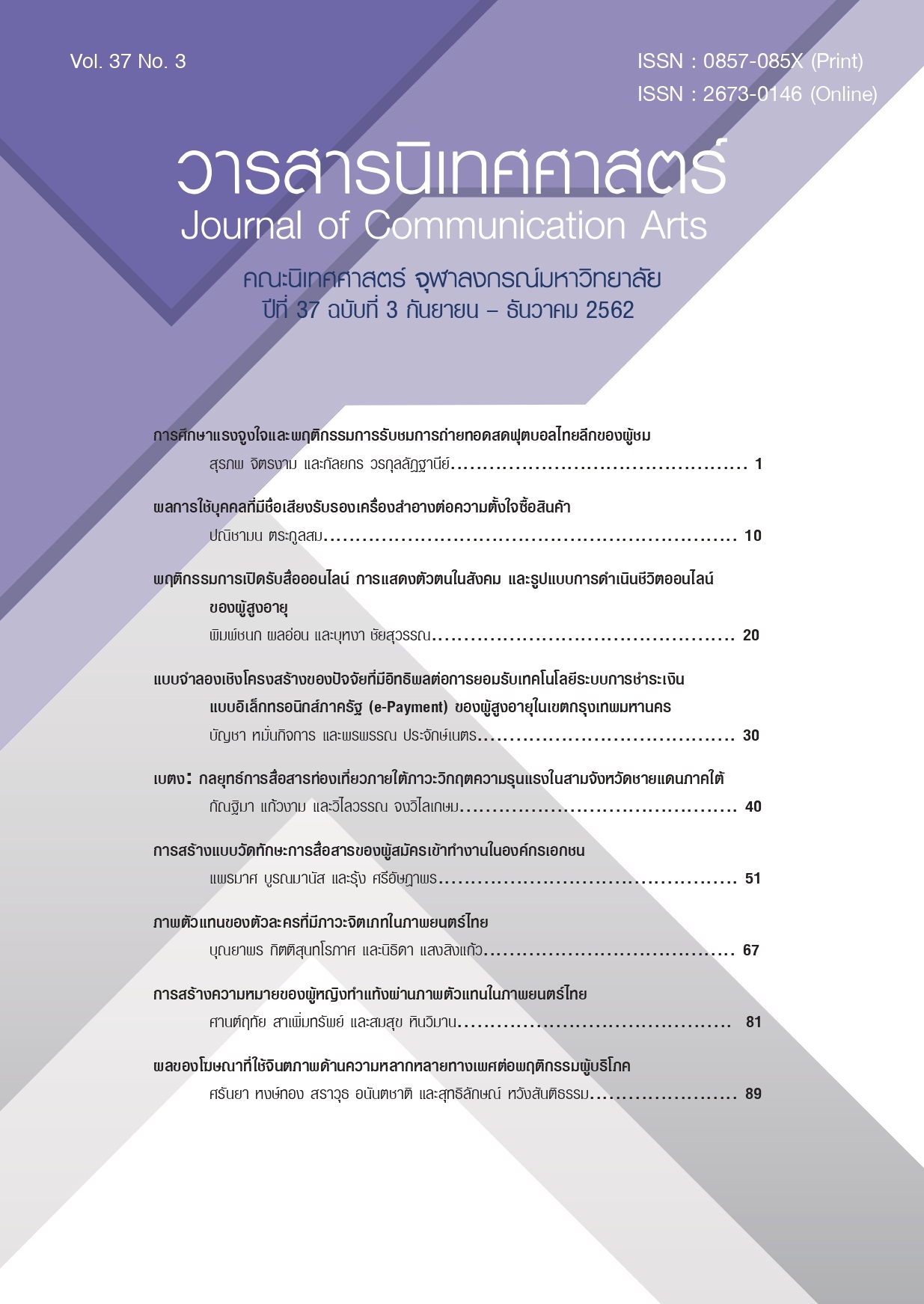Structural Equation Model of Factors Influencing Acceptance of Government Electronic Payment System among Elderly in Bangkok
Main Article Content
Abstract
This research was aimed to: (1) examine perceived risk, perceived security, prior experience, information quality, system quality, service quality, perceived usefulness, perceived ease of use toward acceptance of government electronic payment system among elderly in Bangkok; (2) investigate correlation between perceived risk perceived security, prior experience, information quality, system quality, service quality, perceived usefulness, perceived ease of use, and behavioral intention and acceptance of government electronic payment system among elderly in Bangkok; and (3) validate structural equation model of factors influencing of perceived risk perceived security prior experience information quality, system quality, service quality, perceived usefulness, perceived ease of use and behavioral intention on acceptance of government electronic payment system among elderly in Bangkok. This research is quantitative method by employing of 200 respondents who were elderlies residing in Bangkok. Validated questionnaires with alpha coefficient of 0.722 – 0.923 were used as a research tool. Structural equation model statistical technique was used to analyzed data. The finding revealed that the validation of structural equation model of factors influencing acceptance of government electronic payment system among elderly in Bangkok was in congruence with empirical data, which passes the criteria of 4 form 11 fit indices as follow (1) Chi-Square/df = 2.501 (2) NFI = 0.908 (3)CFI = 0.915, and (4) IFI = 0.917. It also found that information quality, system quality, service quality, perceived usefulness, perceived ease of use and behavioral intention had a direct positive effect on actual government electronic payment system. In addition, perceived risk was found to have a direct negative effect on actual government electronic payment system whereas perceived security, prior experience were found to have an indirect positive effect on actual government electronic payment system.
Article Details
References
ญาณิศา พลอยชุม. (2557). อิทธิพลของคุณภาพระบบต่อการใช้งาน ความพึงพอใจ และประโยชน์สุทธิ ของผู้ใช้บริการทำธุรกรรมทางการเงินผ่านอินเทอร์เน็ต ในกรุงเทพมหานคร. (การศึกษาเฉพาะบุคคลปริญญาบริการธุรกิจมหาบัณฑิต). มหาวิทยาลัยกรุงเทพ.
ฐาวรา หวังสมบูรณ์ดี. (2553). ปัจจัยที่มีผลกระทบต่อการยอมรับอินเทอร์เนตแบงค์กิ้ง กรณีศึกษาพนักงานธนาคารยูโอบี สำนักงานใหญ่ .(การศึกษาเฉพาะบุคคลปริญญาบริการธุรกิจมหาบัณฑิต). มหาวิทยาลัยธรรมศาสตร์.
สำนักงานสถิติแห่งชาติ. (2557). การสำรวจประชากรผู้สูงอายุในประเทศไทย พ.ศ. 2557. สืบค้นเมื่อ 9 มีนาคม 2561 จาก https://goo.gl/Tf7Pdg
สำนักงานสถิติแห่งชาติ. (2560). การสำรวจการมีการใช้เทคโนโลยีสารสนเทศและการสื่อสารในครัวเรือน พ.ศ. 2559. วันที่เข้าถึงข้อมูล 9 มีนาคม 2561 แหล่งที่มา https://goo.gl/Mo2cHn
สำนักยุทธศาสตร์ สำนักงานพัฒนาธุรกรรมทางอิเล็กทรอนิกส์ (องค์การมหาชน) กระทรวงดิจิทัลเพื่อเศรษฐกิจและสังคม. (2560). รายงานผลสำรวจพฤติกรรมผู้ใช้อินเทอร์เน็ตในประเทศไทย ปี 2560. วันที่เข้าถึงข้อมูล 9 มีนาคม 2561, แหล่งที่มา https://goo.gl/cK9STp
สุภมาส อังศุโชติ, สมถวิล วิจิตรวรรณา, และรัชนีกูล ภิญโญภานุวัฒน์. (2554). สถิติการวิเคราะห์สำหรับการวิจัยทางสังคมศาสตร์และพฤติกรรมศาสตร์: เทคนิคการใช้โปรแกรม LISREL (พิมพ์ครั้งที่ 3). กรุงเทพฯ: เจริญดีมั่นคงการพิมพ์.
หนึ่งนุช ธีระรุจินนท์ และวิโรจน์ เจษฎาลักษ์. (2560). คุณภาพการให้บริการธุรกรรมอิเล็กทรอนิกส์ธนาคารกรุงไทย สาขาเอ็มไพร์ทาวเวอร์ กรุงเทพมหานคร. Veridian E-Journal,10(1), 1523–1537. วันที่เข้าถึงข้อมูล 15 มกราคม 2561, แหล่งที่มา https://goo.gl/1nwbH
Nuttachit. (2017). คนไทยใช้ Mobile Banking ทำอะไร. วันที่เข้าถึงข้อมูล 15 มกราคม 2561, แหล่งที่มา https://marketeer.co.th/archives/116876
Oongkhing. (2017). เปิดพฤติกรรมคนไทยกับธุรกิจ e-Payment ที่นักการตลาดควรรู้. วันที่เข้าถึงข้อมูล 15 มกราคม 2561, แหล่งที่มา https://goo.gl/7CZpjd
ภาษาอังกฤษ
Alalwan, A. A., Dwivedi, Y. K., Rana, N. P. P., & Williams, M. D. (2016). Consumer adoption of mobile banking in Jordan. Journal of Enterprise Information Management, 29(1), 118–139. Retrieved January 22, 2018, from https://doi.org/10.1108/JEIM-04-2015-0035
Amin, M. (2016). Internet banking service quality and its implication on e-customer satisfaction and e-customer loyalty. The International Journal of Bank Marketing, 34(3), 280-306. Retrieved January 16, 2018, from https://goo.gl/oVGpiB
Giovanis, A. N., Binioris, S., & Polychronopoulos, G. (2012). An extension of TAM model with IDT and security/privacy risk in the adoption of internet banking services in Greece. Business, EuroMed Journal of, 7(1), 24–53.
Kesharwani, A., & Shailendra, S. B. (2012). The impact of trust and perceived risk on internet banking adoption in India. International Journal of Bank Marketing, 30(4), 303–322. Retrieved January 15, 2018, from https://goo.gl/U6DjRu
Kim, M. J., Chung, N., & Lee, C. K. (2011). The effect of perceived trust on electronic commerce: Shopping online for tourism products and services in South Korea. Tourism Management, 32(2), 256–265.
Pikkarainen, K. (2004). Consumer acceptance of online banking : An extension of the Technology Acceptance Model Consumer acceptance of online banking : an extension of the technology acceptance model, 14(3), 224–235. Retrieved April 4, 2018, from https://doi.org/10.1108/
10662240410542652
Tahir Masood Qureshi, Muhammad Khaqan Zafar, M. B. K. (2008). Customer Acceptance of Online Banking in Developing Economies, Journal of Internet Banking and Commerce, 13(1), 1–10.
Wang, M., Cho, S., & Denton, T. (2017). The impact of personalization and compatibility with past experience on e-banking usage. International Journal of Bank Marketing, 35(1), 45–55. Retrieved April 5, 2018, from https://doi.org/10.1108/IJBM-04-2015-0046
Zhou, T. (2011). An empirical examination of initial trust in mobile banking. Internet Research, 21(5), 527–540. Retrieved April 5, 2018, from https://doi.org/10.1108/10662241111176353

